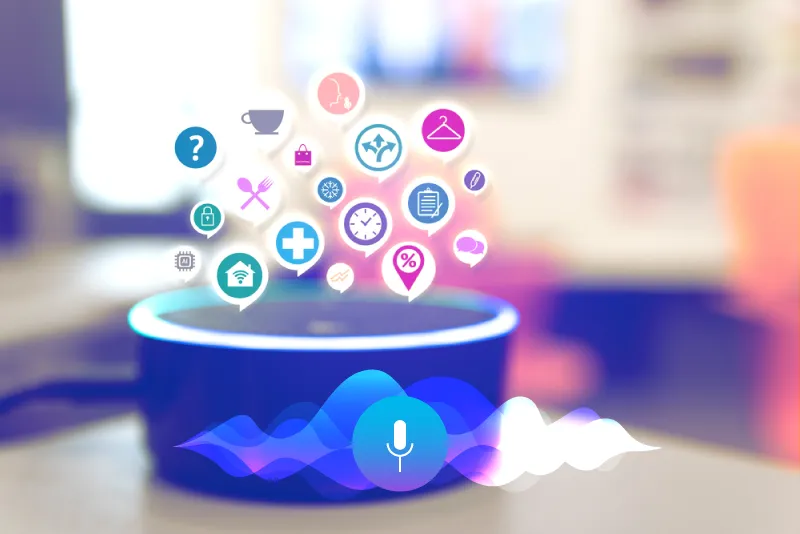Businesses are betting big on voice to rope in and keep customers. Here's why and how they're doing it
Businesses are bringing in voice-based technologies as a part of their future-ready business strategies. And it includes everything from Amazon Alexa and Google Assistant to indigenous solutions from Indian startups.
The once-industrial suburb of Rajajinagar in Bengaluru is the last place you’d expect to see a software startup set up shop. But inside the offices of Gnani.ai, engineers are training a software program in natural language processing by speaking to it in Telugu, Kannada, Tamil and Hindi. One engineer asks the program the cost of carrots in Telugu, and a voice answers, “Rs 20 per kilo” (also in Telugu).
Apart from natural language processing, Gnani.ai, a deep learning and speech recognition AI startup, has also built an engine where Indian farmers and business executives can speak to the program, in their native language. Then the program can also record and transcribe the speech in local languages. For instance, if you are having a business transaction in Hindi, then the voice is transcribed into text by Gnani’s software. Says Ganesh Gopalan, Co-founder,
“We are betting big on voice. It is going to change the way organisations connect with customers. Brands are investing in the natural way of communicating with customers, and that is voice.”

The idea for Gnani.ai was born in 2016 when the founders realised that a great number of Indians don’t know how to type in words into a smart phone. For them, voice was an easier way to communicate instead of touch-typing, as many were only partially literate and probably read better than they could write.
“Voice is the next big business to capture the 300 million Indians in rural areas wanting to go digital,” says Ganesh. It is something we hear about often.
To get to these rural and semi-urban areas, the company is not only working with voice, but with languages. For instance, Gnani.ai’s Co-founder Ananth Nagraj is working on a program where you can transfer money from one bank to another in local languages. Gnani.ai will be used in banks to understand customer sentiment too, and the company already has a couple of pilots running.
Voice is everywhere
Simply put, voice recognition systems allow users to interact with technology by speaking out instructions for a variety of tasks: set an alarm or reminder, search for facts and figures online, find news, play music, and now even purchase something from an online store. The trick, however, is to ensure that it understands different dialects, accents, and deviations from standard instructions while also being intuitive.
Today, AI-based voice services capture data from people on a daily basis. They plan to change the way people interact with businesses or each other. Businesses, in turn, are using voice to operate their apps, which include understanding their customer sentiment. For example, consider that your voice is actually measuring for its sentiment. The BOTs will be programmed to determine whether the tone of your voice is sarcastic, happy, angry, or emotional.
Businesses are not wasting any time to capture voice-as-a-business, and 2019 is the year when popular apps will use voice as a service. One need not look any further than Amazon. The Seattle-based giant is fighting to be the first to make customers use their voice services. Andy Jassy and Werner Vogels of Amazon Web Services (AWS) had a field day while demonstrating the capabilities of its Alexa voice-based service for corporate and consumers alike at the AWS re:Invent 2018. “Voice is going to be big as it allows faster communication with the device,” said Andy, who is CEO of AWS.
Added Werner, CTO of Amazon,
“There is app fatigue and voice is a natural way for humans to communicate.”
Alexa is being used in meeting rooms at Fender, GE and CondeNast. Alexa For Business utilises information about the devices, user accounts, and skills in the organisation. For example, when a user says, “Alexa, start the meeting,” in a conference room, Alexa uses the location of the device, the calendar information for the room, and the type of video conferencing equipment available, all stored on the Alexa for Business account, to start the meeting.
Also read: The flirty Voice
Google's Assistant is not far behind; it is being used at Starbucks, Domino’s, Disney, and Spotify to wow customers. Other large enterprises, too, are working with IT service companies to build voice capabilities using Alexa and Google or building their own.
“We will build on top of existing platforms of Google and Microsoft by using our expertise in AI,” says U B Pravin Rao, COO of Infosys.
Cisco, for instance, has developed its own voice assistant called, Spark, which can be used in an enterprise set up by connecting all business and administration apps.
According to Forrester Research, voice and chat interactions are quickly moving into the mainstream. The ability to talk to devices at home, request information through a chat interface, and place an order while driving a car using only your voice, among other such use cases, is moving from the realm of science fiction into daily life. As voice becomes a commonplace means of interacting with computing systems, application developers must gear up to deliver this increasingly critical functionality.
Vendors of conversational computing platforms range from the largest and most prominent
cloud software development players to specialised solution providers. There are also the development platforms and niche vendors that offer unique and powerful capabilities. Some big examples of such services are Infosys Nia and Manthan’s Maya platforms, which are already being deployed globally.
Forrester also says that IBM Watson, Alexa, and Microsoft have the ability to lead in voice because of its breadth of services, product road map, analytics, UX and app development support. On its website, Microsoft says that there are close to 150 million users of Cortana, mostly users of the Windows operating system.
Amazon itself has allowed integration of its voice service with services and brands like Zoom, Vonage, Cisco, Teem, Ring Central and Creston and is targeting over 4000 businesses to use Alexa. According NPR and Edison Research, 39 million Americans already own a smart speaker like Alexa or Google Home.
In India too, both Alexa and Google Assistant took off in 2018.
The endless opportunities in voice
Leading India’s voice race globally in voice-as-a-service is a startup called Uniphore, which now has a healthy revenue run rate (sources say $20 million, ARR) after its move to the USA in 2017.
Uniphore began building its product in 2008 at IIT Madras and was meant to provide farmers a voice-based solution. Its premise was that the majority of farmers in India would rather use voice to understand the price of the produce rather than press buttons on the mobile phone. Since then, Uniphore has raised $8.8 million in funding in addition to undisclosed funding from Cisco Chairman John Chambers, who also owns a significant chunk of the startup.
Uniphore has gone global, with 40 percent of its revenues coming from the US, with long-term contracts from six customers. Asia still accounts for 60 percent of the company's revenues. American Express, Axis Bank and ITC are among the 100-plus clients in its kitty.

Bank managers can use voice to understand the total deposits that have come into the bank and the total loans disbursed that day. They can also use voice to track the total customers brought in to the bank.
Gene Alvarez, Managing Vice President at Gartner, says that more than half of organisations have already invested in virtual customer assistants (VCAs) for customer service, as they realise the advantages of automated self-service, together with the ability to escalate to a human agent in complex situations.
"As more customers engage on digital channels, VCAs are being implemented for handling customer requests on websites, mobile apps, consumer messaging apps and social networks," Gene says. "This is underpinned by improvements in natural-language processing, machine learning and intent-matching capabilities."
According to Gartner, organisations report a reduction of up to 70 percent in call, chat and/or email inquiries after implementing a VCA. They also report increased customer satisfaction and a 33 percent saving per voice engagement. "A great VCA offers more than just information," says Alvarez. "It should enrich the customer experience, help the customer throughout the interaction and process transactions on behalf of the customer,” he adds.
Voice as a big business
A Gartner survey found that 84 percent of organisations expected to increase investments in customer experience (CX) technology in the year ahead. Other Gartner predictions for CX leaders to know when developing a customer strategy include that by 2019, 20 percent of brands will abandon their mobile apps. Many brands are finding that mobile applications are not delivering the level of adoption and customer engagement they expected.
Original return-on-investment (ROI) calculations are missing the mark due to the cost of support, maintenance, upgrades, customer care and marketing to drive downloads.
Brands are now investing to build presence in consumer messaging apps, such as Facebook Messenger and WeChat, to reach customers where they spend a high percentage of their time. As Rushabh Parmani, co-founder and SVP, Customer Success and Operations at the California-based Automation Anywhere, puts it,
“The cognitive revolution is here to stay, voice is just a part of the whole digital transformation with bots that crunch data and make it easier for humans to manage processes,” says
The company has more than 1,100 enterprise customers and joined the 'unicorn' club last year after raising $300 million in funding from from SoftBank and achieving a valuation of over $1 billion.
Voice, therefore, is big business.
In Bengaluru, analytics player Manthan is building a product where a CEO can command an Alexa-based Bot called Maya to call in sales figures in an organisation on a daily basis by region and location of stores. “We have already been piloting several use cases in the USA where CEOs can use voice to know the status of sales and product,” says Atul Jalan, founder of Manthan.
Even enterprises like SBI, Airbus, ITC, Axis Bank are all betting on voice to understand customer queries and serve them better.
“Typing is not natural. Speech is great way to communicate for mundane tasks,” says Sankara, co-founder of Aryabhatta Robotics, a company that uses voice and vision to identify customers. The company is working on a whole host of technologies from Bengaluru for enterprise. The company was also part of YourStory’s list of TECH30 startups in 2018. It has over 10 customers currently using its product.
“Our algorithm is able to triangulate an individual. We don't stop here, we help retailers and other institutions understand how they can win a loyal customer, what should be done to train an employee, the attention spans of a student,” says Sankara. “The applications are endless.”
Read the first part of our three-part series on how voice is changing the way we interact with technology: How Indian companies are building voice-based services on Amazon Alexa and Google Assistant







